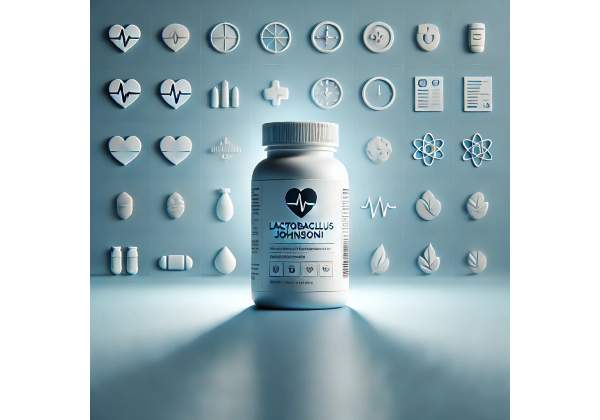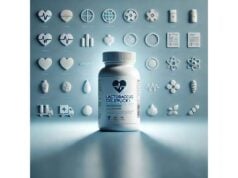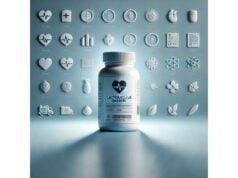
Lactobacillus johnsonii is a human-associated probiotic species often found in the gut and vaginal microbiomes. It is best known for making lactic acid, producing antimicrobial compounds, and strengthening the mucosal barrier—features that help it compete with unwanted microbes and support a steady immune tone. Specific strains of L. johnsonii have been studied for gastrointestinal support, especially in the context of Helicobacter pylori management, as well as for general wellness via immune and metabolic signaling. If you are exploring probiotics for targeted outcomes, this is a species where strain identity, dose, and duration matter. Below, you will find practical guidance on how L. johnsonii works, where clinical evidence is currently strongest, how to select a product, and how to use it safely and effectively. The goal is simple: translate the science into step-by-step decisions you can apply, while being clear about benefits, limitations, and safety signals.
Quick Overview
- Supports gastric and intestinal balance by producing lactic acid and bacteriocins that can suppress problematic microbes.
- May help reduce Helicobacter pylori colonization in some settings and can modulate immune markers linked to gut comfort.
- Typical supplemental intake ranges from 1×108 to 1×1010 CFU/day for 4–12 weeks, depending on the strain and goal.
- Mild, self-limited effects (gas, bloating) are most common; avoid if severely immunocompromised or with central venous catheters.
- Choose strain-identified products (e.g., N6.2, NCC533/La1) with documented CFU at end of shelf life and third-party quality testing.
Table of Contents
- What is Lactobacillus johnsonii?
- Benefits: where evidence is strongest
- How to choose and use L. johnsonii
- Dosage: how much and how long?
- Safety, side effects, and who should avoid it
- What the research says: strain-by-strain snapshot
What is Lactobacillus johnsonii?
Lactobacillus johnsonii is a lactic acid–producing bacterium adapted to human and animal mucosal surfaces. In the gut, it thrives under low-oxygen conditions, turning carbohydrates into lactic acid that lowers local pH and discourages acid-sensitive pathogens. Many L. johnsonii strains also manufacture short peptides and other small molecules—often called bacteriocins—that act like targeted “speed bumps” for competing microbes. These combined effects help stabilize the microbiome and reduce the chance that potentially harmful organisms will take hold.
Mechanistically, L. johnsonii supports the gut barrier in several ways:
- Acidification and colonization resistance. Lactic acid makes the local environment less friendly for sensitive species and can inhibit pathogen enzymes.
- Antimicrobial peptides. Some strains release compounds that directly suppress microbial competitors.
- Mucus and epithelial support. Signals from L. johnsonii can increase mucin expression and tight-junction proteins, helping reduce intestinal permeability.
- Immune calibration. Interactions with dendritic cells, macrophages, and T cells can nudge the immune system toward balanced surveillance rather than chronic activation. Certain strains influence tryptophan metabolism (e.g., shifting the kynurenine:tryptophan ratio), which is one way the gut communicates with systemic immunity.
A distinct feature of L. johnsonii is its strain diversity. The benefits you’ll see on a label—such as comfort in the upper gastrointestinal tract or support during antibiotic exposure—are determined by the specific strain’s genetics and surface molecules. For example, N6.2, La1 (also known as NCC533), and other well-described strains differ in how they bind to mucosal surfaces, the enzymes they express, and the metabolites they release. This is why experts emphasize selecting strain-identified products over generic species listings.
Where does L. johnsonii show up in daily life? Beyond supplements, certain fermented milks and yogurts have used defined strains (e.g., La1) in clinical settings. In the body, it is part of the normal gut community for many people and also appears in the vaginal microbiome, where lactic acid and bacteriocins help maintain a protective, low-pH environment. All that said, consistent benefits are most likely when you use a characterized strain at an adequate CFU dose for enough weeks to allow mucosal engagement.
In summary, L. johnsonii is not a cure-all, but it is a well-studied, mucosa-adapted species with plausible mechanisms—acidification, antimicrobial production, barrier support, and immune signaling—that translate into targeted benefits when an appropriate strain is matched to the right goal.
Benefits: where evidence is strongest
Upper GI support (Helicobacter pylori management). Several trials have explored whether specific L. johnsonii strains can influence H. pylori colonization in children and adults. While these studies are not substitutes for standard eradication regimens, they suggest that daily intake of strain-specific products may reduce H. pylori load and modestly improve gastric comfort markers in some contexts. The signal is strongest for La1 (NCC533) in fermented milk formulations given over a few weeks. Results often show modest, not complete, effects, and benefits typically wane after stopping the probiotic—so it is best framed as supportive care rather than standalone treatment. For people working with a clinician to manage H. pylori, adding a vetted L. johnsonii strain may be reasonable to discuss, especially to support tolerance of standard therapies.
Immune and wellness modulation. In healthy adults, a randomized, double-blind trial of the N6.2 strain documented good tolerance and measurable immune shifts (for example, changes in circulating T-cell subsets and a lowered kynurenine:tryptophan ratio). Participants also reported fewer minor complaints related to abdominal discomfort and headaches during use. These findings align with cellular and molecular work showing that L. johnsonii can interact with dendritic cells and macrophages in ways that promote a balanced, “not too hot, not too cold” immune tone.
Barrier and epithelial support. Preclinical and translational data suggest that certain L. johnsonii strains enhance mucin production, tight-junction integrity, and epithelial renewal. Although most barrier data are from animal or cell models, they map to the practical outcomes many users care about: less reactivity to everyday dietary triggers and more predictable digestion. Strains differ here—some are especially good at producing extracellular vesicles (EVs) that carry bioactive lipids and proteins capable of signaling to distant tissues, including pancreatic and immune cells. EV-related mechanisms help explain how a gut-resident microbe could plausibly exert systemic effects.
Who is most likely to benefit?
- Individuals seeking adjunctive support during a clinician-led H. pylori plan (never as a replacement).
- People who want to nudge immune tone toward balance, with a goal of gut comfort and fewer day-to-day digestive complaints.
- Those interested in microbiome maintenance after antibiotics or during travel, provided they choose a strain with demonstrated survivability.
Where is evidence limited? Claims around weight loss, skin benefits, or mood require far more strain-specific, controlled human studies. Early signals are interesting but not definitive. Treat bold claims cautiously—focus on strains and outcomes that have been directly documented in humans.
Bottom line: L. johnsonii shows the most consistent benefits in the upper GI niche and in immune-modulation contexts, with additional promise emerging from mechanistic work on barrier function and extracellular vesicle signaling.
How to choose and use L. johnsonii
Choosing a probiotic is less about brand loyalty and more about matching a named strain to a specific goal. Use this checklist to raise your odds of getting what the label promises:
- Demand strain identity. The label should list the full strain name (e.g., Lactobacillus johnsonii N6.2, NCC533/La1, MH-68). Species-only labels (“L. johnsonii blend”) are a red flag because benefits are strain-specific.
- Match the outcome.
- For upper GI support during H. pylori management: look for La1 (NCC533) or a strain with clearly documented in-human gastric outcomes.
- For immune/wellness calibration: consider N6.2, which has randomized clinical data in healthy adults showing immune and metabolite shifts.
- Check the CFU dose at end of shelf life. You want the guaranteed CFU through the expiration date, not “at manufacture.” For L. johnsonii, effective daily intakes generally fall between 1×108 and 1×1010 CFU.
- Look for supporting documents. Trustworthy products provide certificates of analysis (CoA), third-party testing, and stability data demonstrating survivability at room temperature or with refrigeration, as applicable.
- Mind the delivery form.
- Capsules: convenient and dose-known; consider delayed-release forms if you are acid-sensitive.
- Fermented dairy drinks or yogurts: some clinical trials used these for strain delivery in children; if dairy-intolerant, choose capsules.
- Plan the duration. Probiotics work while you take them. Aim for 4–12 weeks depending on your goal, then reassess. If you stop and the benefit fades, it is common—not necessarily a failure.
- Store correctly. Follow the label: some strains are shelf-stable; others require refrigeration. Heat and moisture are the enemies of viability.
- Combine thoughtfully. L. johnsonii can be used alongside prebiotics (dietary fibers) and with many multistrain blends. If pairing with antibiotics, separate the timing by a few hours and continue for 1–2 weeks after the course ends (with your clinician’s okay).
A note on expectations. Probiotics do not overwrite a poor dietary pattern. A fiber-rich, minimally processed diet gives L. johnsonii and its allies the substrates they need to produce beneficial acids and metabolites. Keep hydration consistent and consider walking after meals to aid motility—small habit changes often amplify what a probiotic can do.
When to stop or switch. If you experience ongoing bloating, cramping, or irregularity beyond the first 7–10 days, consider reducing the dose or switching strains. If you do not detect any benefit by week 4, switching to a strain with stronger human data for your goal is reasonable.
Dosage: how much and how long?
Typical daily intake: For most adult uses, 1×108 to 1×1010 CFU/day is a practical range. Think of this as the “therapeutic window” commonly used in clinical trials and quality products. Within that range:
- Immune and wellness modulation (adults): Some trials with N6.2 used 1×108 CFU/day for 8 weeks, showing good tolerance and measurable immune effects. If you have not used probiotics before, starting closer to 1×108–5×109 CFU/day can reduce early gas or bloating.
- Upper GI support (H. pylori management): Studies in children tested daily fermented milk or juice-plus-probiotic regimens for 3–4 weeks with La1 (NCC533), observing modest reductions in colonization. Adult products for this goal often fall in the 1×109–1×1010 CFU/day range.
Timing with meals: Take with the first bites of a meal or within 30 minutes before eating. Food buffers stomach acid and helps more cells reach the small intestine viable.
Duration:
- For digestive comfort or immune calibration: plan 8–12 weeks before judging the effect.
- For adjuvant H. pylori support: 3–4 weeks around a clinician-directed plan is common, though some people continue longer for general gastric comfort.
Tapering and maintenance: If you notice clear benefits by week 8–12, you can test a step-down to every other day or lower CFU and see if the benefit holds. People often find a maintenance cadence that fits their routine and symptoms.
Special groups:
- Children: Use child-specific products and doses validated for pediatrics. Many kid-focused products deliver 1×108–1×109 CFU/day per strain.
- Older adults and those with reduced stomach acid: A lower starting dose with slow titration may reduce bloating; consider delayed-release capsules.
- During antibiotics: Separate doses by 2–3 hours from the antibiotic, and continue for 1–2 weeks after finishing the course.
Signs you may be under- or over-dosing:
- Too low: no change after 4–6 weeks (if adherence is good and the strain matches your goal).
- Too high, too fast: persistent gas, cramping, or looser stools beyond the first week—reduce the dose or frequency.
Remember, CFU is the viable cell count at the end of shelf life. Products should guarantee CFU through expiration. If the label only lists CFU “at manufacture,” you have less assurance you’re getting the intended dose.
Safety, side effects, and who should avoid it
Overall safety profile. L. johnsonii is generally well tolerated in healthy adults and children when used at studied doses. The most common effects are transient, such as mild gas, bloating, or stool changes during the first week—signs of a microbiome adjusting to new inputs. These typically fade as your gut adapts. If they do not, lower the dose or pause.
Who should avoid or seek medical guidance first:
- Severely immunocompromised individuals (e.g., neutropenia, uncontrolled HIV, active hematologic malignancy).
- People with central venous catheters or prosthetic heart valves, where any microorganism translocation carries higher risk.
- Those with short bowel syndrome, critical illness, or immediately post-abdominal surgery unless specifically recommended by a specialist.
- Anyone with a history of probiotic-associated bacteremia (rare) or known allergy to product excipients (e.g., dairy proteins in some fermented milks).
Drug and condition interactions.
- Antibiotics: Most L. johnsonii strains can be taken during antibiotic regimens if separated by 2–3 hours, but always coordinate with the prescriber.
- Proton pump inhibitors (PPIs): Lower gastric acidity can raise survival of ingested bacteria; this is not inherently harmful but can change how you respond, especially at higher CFU.
- Pregnancy and breastfeeding: Generally considered safe when using food-grade, strain-identified products at customary doses; still, discuss with your clinician.
Quality and contamination. Use brands that disclose strain identity, CFU at expiration, third-party testing, and all excipients. Avoid products that obscure these details. Store as directed to preserve viability.
When to seek care. If you develop fever, chills, worsening abdominal pain, blood in stool, or any symptom that feels out of proportion, stop the probiotic and contact your clinician. These are uncommon but warrant evaluation.
Special note on expectations. Probiotics should complement—not replace—standard medical care. For H. pylori, inflammatory bowel disease, or other diagnoses, always integrate L. johnsonii within a plan supervised by a healthcare professional.
What the research says: strain-by-strain snapshot
NCC533 (La1). This classic, food-grade strain has been tested in children for H. pylori colonization modulation. Trials using daily fermented milk for 3–4 weeks reported modest reductions in H. pylori load and higher odds of temporarily testing negative on breath tests compared with controls. Importantly, effects tended to diminish after a washout period, underscoring that La1 acts as a supportive measure rather than an eradication therapy. Mechanistic work suggests La1 acidifies the niche and interferes with H. pylori adhesion, while dampening gastric inflammatory markers. In the clinic, La1 is often considered as an adjunct to standard care.
N6.2. A randomized, double-blind adult trial administering 1×108 CFU/day for 8 weeks showed good tolerance and immune modulation, including changes in T-cell subsets and a shift in tryptophan metabolism (lower kynurenine:tryptophan ratio). Laboratory studies illuminate why: N6.2 produces bioactive lipids and extracellular vesicles (EVs) that engage dendritic cells and macrophages and may influence distant tissues like pancreatic cells. Newer work indicates that bile exposure can increase EV production, potentially amplifying host-microbe signaling during intestinal transit. Together, these findings position N6.2 as a strong candidate for immune-calibration and gut-comfort use cases in otherwise healthy adults.
MH-68 and others. Early investigations suggest that additional L. johnsonii strains (e.g., MH-68) may suppress H. pylori viability and gastric chemokines in vivo, but the body of human data is smaller than for La1 and N6.2. As more strains are cataloged, expect clearer separation of use-cases (upper GI focus versus broader immune tone or barrier support).
How to interpret this evidence.
- Consistency matters. Strain-specific, repeated signals across trials (even if modest) are more meaningful than single studies with large claimed effects.
- Adjunct, not replacement. For H. pylori, L. johnsonii is a helper, not a primary treatment. For general wellness, it is part of a stack that includes diet, sleep, and stress care.
- Mechanism-guided choices. If your goal is immune calibration and digestive comfort, N6.2 has human and mechanistic data that align with that aim. For upper GI support, La1 has the most practical experience.
Where the field is going. Expect more omics-guided personalization, where EV signatures, lipid profiles, and adhesion genes help match strains to individuals. Delivery innovations (e.g., bile-responsive microencapsulation) may also improve survivability and the reproducibility of clinical effects. For now, the practical path is simple: pick a named strain tied to your outcome, dose realistically for 4–12 weeks, and reassess.
References
- Effect of the ingestion of a dietary product containing Lactobacillus johnsonii La1 on Helicobacter pylori colonization in children 2003 (RCT)
- Modulation of Helicobacter pylori colonization with cranberry juice and Lactobacillus johnsonii La1 in children 2008 (Multicenter RCT)
- Lactobacillus johnsonii N6.2 Modulates the Host Immune Responses: A Double-Blind, Randomized Trial in Healthy Adults 2017 (RCT)
- Lactobacillus johnsonii N6.2 phospholipids induce immature-like dendritic cells with a migratory-regulatory-like transcriptional signature 2023 (Mechanistic)
- Bile promotes Lactobacillus johnsonii N6.2 extracellular vesicle production with conserved immunomodulatory properties 2024 (Mechanistic)
Disclaimer
This information is educational and is not a substitute for personalized medical advice, diagnosis, or treatment. Do not start, stop, or replace prescribed therapies based on this article. If you have a medical condition, are pregnant or breastfeeding, are immunocompromised, or are considering L. johnsonii alongside antibiotics or other treatments, consult a qualified healthcare professional first.
If you found this helpful, please consider sharing it on Facebook, X (formerly Twitter), or your preferred platform, and follow us for new evidence-based guides. Your support helps us continue creating high-quality, people-first articles.










